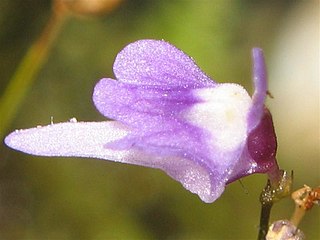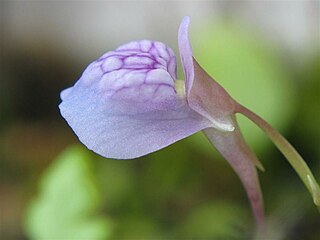Utricularia punctata is a medium-sized suspended aquatic carnivorous plant that belongs to the genus Utricularia. U. punctata is native to Borneo, Burma, China, Peninsular Malaysia, Sumatra, Thailand, and Vietnam.
Utricularia buntingiana is a small epiphytic, perennial carnivorous plant that belongs to the genus Utricularia. U. buntingiana is endemic to Venezuela, where it is only known from a few locations: the type location in Henri Pittier National Park, one collection on the Paraguaná Peninsula, and a few others from Falcón. It was originally published and described by Peter Taylor in 1975. Its habitat is reported as being mossy trees in montane forests at altitudes from 830 metres (2,723 ft) to 1,775 metres (5,823 ft). It has been seen flowering in June and July. Both U. buntingiana and U. praetermissa possess a double-curved corolla spur.
Utricularia geoffrayi is a small, probably perennial, terrestrial carnivorous plant that belongs to the genus Utricularia. U. geoffrayi is native to Indochina and can be found in Cambodia, Thailand, and Vietnam. It was originally published and described by François Pellegrin in 1920. It grows as a terrestrial plant among short grasses in or around rice fields at altitudes from sea level to 1,300 m (4,265 ft). It has been collected in flower between September and December.
Utricularia hirta is a small, probably perennial, terrestrial carnivorous plant that belongs to the genus Utricularia. U. hirta is native to India and Southeast Asia, where it can be found in Bangladesh, Cambodia, Laos, Sri Lanka, Thailand, and Vietnam and on the island of Borneo. It was originally named by Jacob Theodor Klein and formally described and published by Johann Heinrich Friedrich Link in 1820. It grows as a terrestrial plant in damp or wet open areas or marshes at altitudes from sea level to 1,000 m (3,281 ft). It has been collected in flower between July and December.

Utricularia minutissima is a small or very small terrestrial carnivorous plant that belongs to the genus Utricularia. U. minutissima is native to Asia and Australia. Among the islands of Southeast Asia, it is found on Borneo, New Guinea, and Sumatra.
Utricularia appendiculata is a medium-sized, probably perennial, terrestrial carnivorous plant that belongs to the genus Utricularia and is the only member of Utricularia sect. Oliveria. U. appendiculata is endemic to Africa, where it can be found in Burundi, Cameroon, the Central African Republic, the Democratic Republic of the Congo, Gabon, Madagascar, Malawi, Mozambique, Tanzania, Uganda, and Zimbabwe. It grows as a terrestrial plant in wet Sphagnum bogs, damp sandy savannas, or in peaty marshes at altitudes from 1,500 m (4,921 ft) to 1,860 m (6,102 ft), but as low as 700 m (2,297 ft) in the Central African Republic. It flowers mostly in the wet season. It was originally published and described by Eileen Adelaide Bruce in 1933 and was placed in its own section, Oliveria, in 1986 by Peter Taylor.
Utricularia pentadactyla is a small annual carnivorous plant that belongs to the genus Utricularia. It is native to tropical Africa, where it can be found in Angola, Burundi, the Democratic Republic of the Congo, Ethiopia, Kenya, Malawi, Sudan, Tanzania, Uganda, Zambia, and Zimbabwe. U. pentadactyla grows as a terrestrial plant in damp, sandy or peaty soils in grasslands or shallow soils over rock at altitudes from 1,500 m (4,921 ft) to 2,100 m (6,890 ft). It was originally described and published by Peter Taylor in 1954, the first Utricularia species described by Taylor.

Utricularia bifida is a small annual carnivorous plant that belongs to the genus Utricularia. It is native to Asia and Oceania and can be found in Australia, Bangladesh, Burma, Cambodia, China, Guam, India, Indonesia, Japan, Korea, Laos, Malaysia, Nepal, New Guinea, Palau, the Philippines, Sri Lanka, Thailand, and Vietnam. U. bifida grows as a terrestrial plant in damp soils and in rice fields. It was originally described and published by Carl Linnaeus in 1753.
Utricularia delphinioides is a small to medium-sized, probably perennial, carnivorous plant that belongs to the genus Utricularia. It is endemic to Indochina and can be found in Cambodia, Laos, Thailand, and Vietnam. U. delphinioides grows as a terrestrial plant in swamps and rice fields, wet grasslands, or open pine forests at altitudes from near sea level to 1,300 m (4,265 ft). It was originally named by Clovis Thorel but formally described and published by François Pellegrin in 1920. A variety, U. delphinioides var. minor, was also described in 1920, but Peter Taylor reduced the variety to synonymy under U. delphinioides because he discovered a continuous range of sizes between the larger and smaller forms, size being the only distinctive characteristic in the 1920 description of the variety.

Utricularia graminifolia is a small perennial carnivorous plant that belongs to the genus Utricularia. It is native to Asia, where it can be found in Burma, China, India, Sri Lanka, and Thailand. U. graminifolia grows as a terrestrial or affixed subaquatic plant in wet soils or in marshes, usually at lower altitudes but ascending to 1,500 m (4,921 ft) in Burma. It was originally described and published by Martin Vahl in 1804. It has also recently been grown in planted aquaria.

Utricularia involvens is a medium-sized, probably perennial, carnivorous plant that belongs to the genus Utricularia. It grows naturally in southeastern Asia and northern Australia. U. involvens grows as a terrestrial plant in wet grasslands or open vegetation, usually at low altitudes but ascending to 900 m (2,953 ft) in Malaysia. It was originally described and published by Henry Nicholas Ridley in 1895.
Utricularia pierrei is a medium-sized, probably perennial carnivorous plant that belongs to the genus Utricularia. It is native to Indochina and can be found in Thailand and southern Vietnam. U. pierrei grows as a terrestrial plant at altitudes around 1,500 m (4,921 ft). It was originally described by François Pellegrin in 1920 in honor of the original collector of the species.

Utricularia scandens is a small, probably annual carnivorous plant that belongs to the genus Utricularia. It has a wide native distribution that includes Africa and Asia. U. scandens grows as a terrestrial plant in wet grasslands and bogs at lower altitudes around sea level up to 2,300 m (7,546 ft). It was originally described by Ludwig Benjamin in 1847. There is a significant amount of synonymy established for this species, in part because of its large distribution and variable morphology.

Utricularia uliginosa, the Asian bladderwort, is a small annual carnivorous plant that belongs to the genus Utricularia. It is native to Southeast Asia, Oceania, and Australia. U. uliginosa grows as a terrestrial or subaquatic plant in seasonally flooded shallow pools with sandy soils or on banks and among rocky stream beds at low altitudes. It was originally described by Martin Vahl in 1804.
Utricularia forrestii is a small perennial carnivorous plant that belongs to the genus Utricularia. Its native distribution includes northern Burma and western China. It is represented in herberia by only four specimens. U. forrestii grows as a lithophyte on rocks among mosses at altitudes from 2,100 m (6,890 ft) to 3,000 m (9,843 ft). It was originally described by Peter Taylor in 1986 and named in honor of George Forrest.
Utricularia furcellata is a small annual carnivorous plant that belongs to the genus Utricularia. It is native to northeast India and Thailand, suggesting that it may also occur in suitable habitats in the regions in between. U. furcellata grows as a lithophyte on moist rocks at altitudes from 1,500 m (4,921 ft) to 2,700 m (8,858 ft). It was originally described by Daniel Oliver in 1859.
Utricularia garrettii is a small perennial carnivorous plant that belongs to the genus Utricularia. It is endemic to Thailand where it is only known from the type locality and represented by a single specimen. U. garrettii grows as a lithophyte on moist rocks at altitudes around 2,175 m (7,136 ft). It was originally described by Peter Taylor in 1986 from a collection by H. B. G. Garrett in 1910. As of Taylor's 1989 revision of his monograph, it had not been recollected since Garrett's original collection. It is most similar to U. striatula and can be easily confused for it.
Utricularia kumaonensis is a small annual carnivorous plant that belongs to the genus Utricularia. It is native to Bhutan, northern Burma, the Yunnan province of China, India, and Nepal. U. kumaonensis grows as a lithophyte, epiphyte, or terrestrial plant on mossy rocks or in bog grasslands at altitudes from 2,250 m (7,382 ft) to 4,200 m (13,780 ft). It was originally described by Daniel Oliver in 1859, although Peter Taylor asserted in his 1989 monograph that Michael Pakenham Edgeworth's 1847 description of Diurospermum album is U. kumaonensis. It is very similar to U. multicaulis.
Utricularia multicaulis is a very small annual carnivorous plant that belongs to the genus Utricularia. It is native to Bhutan, Burma, China, India, and Nepal. U. multicaulis grows as a lithophyte or terrestrial plant on wet rocks or open swampy meadows with mosses at altitudes from 1,800 m (5,906 ft) to 4,000 m (13,123 ft). It was originally described by Daniel Oliver in 1859.
Utricularia jackii is a terrestrial carnivorous plant that belongs to the genus Utricularia. It is endemic to Thailand. U. jackii grows among wet rocks at higher altitudes or sometimes in evergreen forests. It was first collected in 1927 and again in 1958. In his 1989 revision of his monograph, Peter Taylor discussed the specimen and identified it as potentially distinct, but never formally described it. John Adrian Naicker Parnell located the herbarium specimens in preparation for a review of Lentibulariaceae of Thailand and formally described it as a new species in 2005. Parnell named it in honor of his father, John "Jack" Thomas Mackie Parnell.





